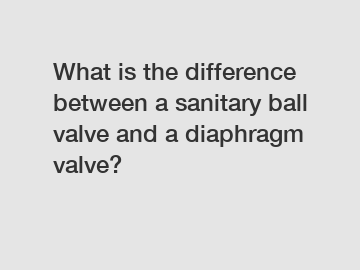What is the difference between a sanitary ball valve and a diaphragm valve?
Link to HY
What is the difference between a sanitary ball valve and a diaphragm valve?
Sanitary ball valves and diaphragm valves are both widely used in various industries for controlling the flow of fluids. While they may serve similar purposes, there are significant differences between these two types of valves. So, let's dive in and explore the distinctions between a sanitary ball valve and a diaphragm valve.

First, let's understand the basic functionalities of these valves. A ball valve is a quarter-turn valve that uses a spherical ball with a hole through its center to control fluid flow. On the other hand, a diaphragm valve uses a flexible diaphragm made of elastomer or synthetic materials to control flow. Now, let's discuss the differences between these valves using the following points:
1. Design and Construction:
The design of sanitary ball valves involves a ball within a valve body that has a bore through which the fluid flows. The ball has a hole (port) that aligns with the flow path when the valve is open. When the valve is closed, the ball rotates 90 degrees to block the flow. Diaphragm valves, on the other hand, use a flexible diaphragm that is seated against a weir or saddle within the valve body to control flow. The diaphragm is either raised or lowered to allow or restrict flow.
2. Fluid Containment:
A sanitary ball valve offers excellent fluid containment due to its design with a sealing mechanism, typically achieved by compressing an elastomeric seat against the ball. This ensures tight shut-off and prevents any leakage. In contrast, a diaphragm valve provides superior sealing due to the diaphragm's flexible construction, which creates a tight seal against the weir or saddle. This makes diaphragm valves highly reliable in preventing leaks.
3. Flow Control:
When it comes to flow control, sanitary ball valves offer precise control since the flow passage is a straight line from the inlet to the outlet when the valve is open. This design reduces pressure drop and allows for higher flow rates. Conversely, diaphragm valves may have a slightly higher pressure drop due to the flow path around the diaphragm. However, they offer a linear flow characteristic, allowing for better throttling control.
4. Cleanability and Sterilization:
In applications where cleanliness and sterilization are crucial, sanitary ball valves are often the preferred choice. Their design allows for easy disassembly and cleaning, enabling effective removal of contaminants. Diaphragm valves, too, can be dismantled for cleaning purposes, but their complex valve bodies and internal diaphragms might pose challenges for complete sterilization.
In conclusion, while both sanitary ball valves and diaphragm valves serve as effective tools for flow control, their design, functionality, and applications differ significantly. Sanitary ball valves are suited for systems demanding precise control and high flow rates, with easy cleanability and sealing capabilities. On the other hand, diaphragm valves shine in applications where superior seal reliability, linear flow control, and moderate pressure drop are essential. By understanding their differences, one can make an informed choice in selecting the right valve for their specific application.
For more information, please visit our website.
For more pneumatic actuated ball valve supplierinformation, please contact us. We will provide professional answers.



